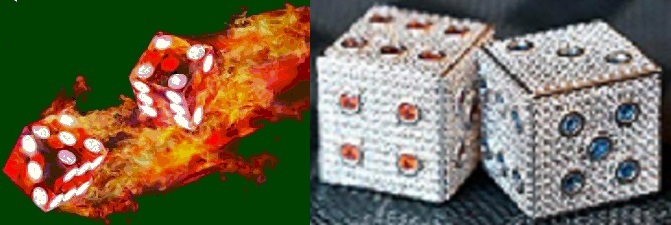

Musical Dice -- The PM Strategies
Written September 17, 2022
No, the title is NOT a reference to the time of the day these strategies should be played. They can be played at any time, even before 12 noon. ☺ Actually, the PM in this case stands for Press-Martingale. And the title is an umbrella name for three related strategies, which I call the PM 68 Strategy, the 4 PM Strategy, and the 6 PM Strategy.
So what is a PM strategy? An over-simplified explanation is, when a Place bet is hitting, alternately press and take until the seven-out. But if the Place Bet is losing, Martingale (or double) it up until it hits. And the three different names for the strategies, refer to which Place bets you play. On the PM 68 strategy, it's only the 6 and 8 that you play. On the 4 PM strategy, it's the inside numbers (5, 6, 8, and 9) that you play. And for the 6 PM strategy, it is all six Place bet numbers that you play. And each number is treated like a separate entity.
To start this strategy, after a point is established, place the minimum bets on each of the Place bets you intend to play. Then take the first hit on each individual number. Then press the number up on the second hit. Again, each number is treated like a separate entity, so, if you're playing the PM 68 strategy, and the 6 hits twice, press the 6 with the second hit. No need to wait until the 8 is paid for. In this manner, continue taking and pressing until the seven-out, at which point, you return the bets to minimum or base levels, if they were pressed up. You switch from Press mode to Martingale mode for that number.
If the seven comes before the number hits, the next round, that's when you Martingale the bet up. In the case of of the PM 68 strategy, let's say the table is a $10 table, and the six hits twice, that means that the six will be pressed up to $24. But if the seven then hits, the six will go back down to $12 for the next round, but the 8 will be Martingaled up to $24. If a seven-out comes before the 8 hits, then the bet is Martingaled up again, in this case, to $48. But when the bet is hit on a Martingale, the bet is then reduced to base level (in this case, $12), and you will switch from Martingale mode to Press mode for that number.
Three special notes on this: (1) After a Martingaled bet has been hit, and it has been taken back to base letel, on the next hit, you can press it up immediately, for the hit at the Martingaled level, paid for the bet at the base level. (2) When a bet has been pressed up to the second level, and it hits again, you may want to use the proceeds from that hit to get two of the other numbers started (if playing the PM 68 strategy, or the 4 PM strategy). (3) If you have bets Martingaled up, but yet and still, you're ahead, you may want to keep those Martingaled bets up at the elevated levels, instead of bringing them down when they hit. Also, if the seven-out hits while you're ahead, you may not want to Martingale anything, but bring all the bets back to base level (it may also be a good time to leave the table, as you are ahead). All of this is totally up to you.
As with any strategy that involves Martingaling bets, you'll need a somewhat large bankroll, big enough to cover all your bets being Martingaled several times.
If you're just starting out playing a PM strategy, I suggest you start out playing the PM 68 strategy, because it's much harder to keep track of 4 or 6 numbers, as to which ones are in Press mode, and which ones are in Martingale mode. And the bankroll you'll need is less than if you are potentially Martingaling 4 or 6 numbers, as opposed to two.
There is no guarantee that any strategy will always work, and this strategy is no exception. For the big risk is in Martingaling bets up, as that can get very expensive very fast. And if your bankroll completely depletes before your Martingaled bets can hit, you're really out of luck. I present this strategy as merely one more weapon to have in your craps-playing arsenal. Good luck! ☺